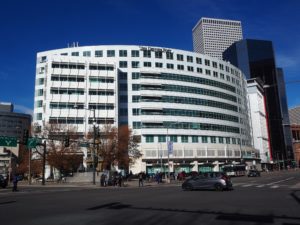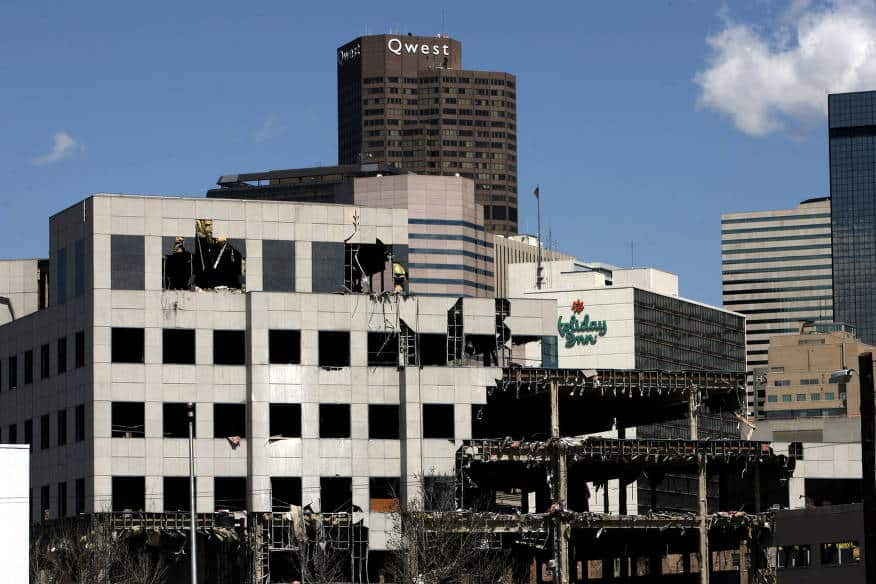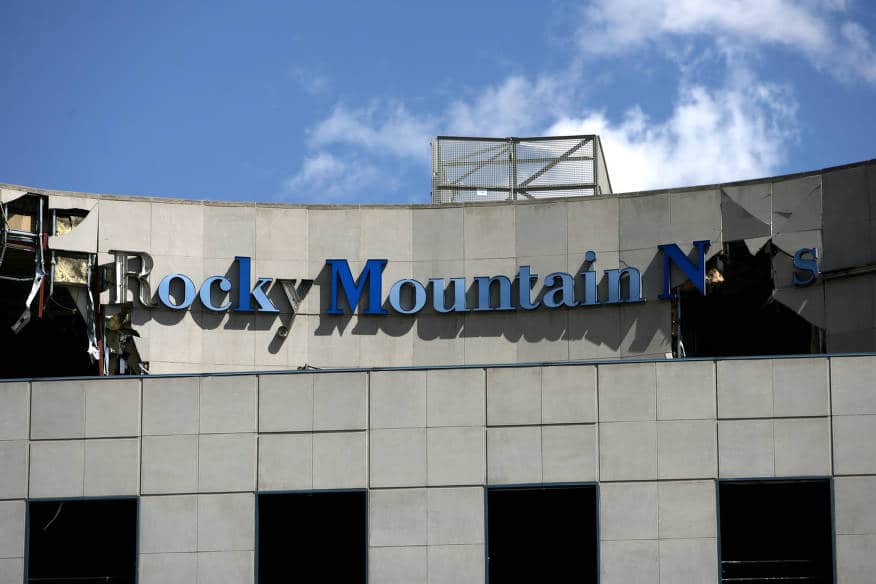
Denver Newspaper Agency employees look out from the 10th-floor patio of the 101 W. Colfax Ave. building on Aug. 3, 2006. (Rocky Mountain News via Denver Public Library)
Denver’s planned purchase of the former Denver Post building won’t be the first time the city has bought a dominant daily newspaper’s signature real estate.
In 2002, the city bought the building used by the Rocky Mountain News, the Post’s main rival for decades. The structure sat at 400 W. Colfax Ave., just west of Denver city hall and the Denver Mint.
Unlike the former Post building at 101 W. Colfax Ave., which the city intends to keep using as office space, the Rocky’s building was demolished.

The building at 101 W. Colfax Ave. (BusinessDen file)
In both cases, however, the deals were intended to allow for expansion of the court system.
The Denver Justice Center and Lindsey-Flanigan Courthouse now sit where the former Rocky building once stood. And the city intends to house court staff, judicial advocate services such as Colorado Legal Services and rental assistance programs in the 101 W. Colfax building.
The Rocky was established in 1859, more than 30 years before The Denver Post. The publication moved to 400 W. Colfax Ave. in June 1952, according to the Denver Public Library.
In 2000, the Rocky and Post agreed to a joint operating agreement, maintaining separate newsrooms while sharing business staff. Both published six days a week, with the broadsheet Post taking Saturday off and the tabloid Rocky skipping Sunday.
The decision to construct a new facility for both newspapers at 101 W. Colfax Ave. — the building the city now plans to buy — made the Rocky’s facility three blocks west no longer needed.

The old Rocky Mountain News building, with the Denver skyline behind it, undergoes demolition on April 9, 2007. (Rocky Mountain News via Denver Public Library)
The city paid $16 million in late 2002 for the 400 W. Colfax property, public records show.
“A single owner willing to sell over 5 acres only one block from city hall offers the City the opportunity to return City Hall to a civic building and enhance our civic complex. This undertaking should complement the city’s recent investments in the Civic Center such as the new art museum, public library and the new Webb municipal office building,” then-mayor Wellington Webb said that year.
The Post and Rocky moved to 101 W. Colfax when the building was completed in 2006. The city demolished the former Rocky building the next year to allow for construction of the court and jail facilities.
John Rebchook, who covered real estate for the Rocky from 1983 until its closure, said staff there didn’t mind seeing their old building at 400 W. Colfax come down, since the new joint building was clearly an upgrade.
“It just wasn’t a nice building, really,” he said. “It would probably be considered a Class C building.
“Nobody was sentimental about the old building. The only thing some people were upset about was parking was cheaper at the old building.”

Rocky Mountain News signage sits atop the building at 400 W. Colfax Ave. as it undergoes demolition on April 9, 2007. (Rocky Mountain News via Denver Public Library)
The Rocky closed in 2009 amidst a broader cratering of the newspaper industry. Its signage was removed from atop 101 W. Colfax that year, leaving just the Denver Post signage that remains.
The Post moved to 101 W. Colfax from Civic Center Plaza, a 22-story office building at 1560 Broadway where it had operated since 1992. That building still stands. Prior to that, Rebchook said, the Post’s newsroom was where the Hyatt Regency Denver At Colorado Convention Center is now.
The Post has a master lease for the 101 W. Colfax building through October 2029, but the newspaper and its parent company haven’t used the building for years. The Post has subleased the space to other users, including the city.
The city didn’t respond to a request for comment regarding whether signage for the Post would remain atop 101 W. Colfax after the city buys it.
Major newspapers historically opted to locate their newsrooms close to the halls of government power, to allow for easy access to public meetings and elected officials. The locations also spoke to the power of the news organizations and their commitment to serving as a watchdog of those in power.
Many publications, however, have shed that prime real estate in recent years as the industry has suffered declining revenue.
Rebchook, who later wrote for the Colorado Real Estate Journal and is now retired, said the real landmark moment for the Post building was when the newspaper moved out, not now when the city is set to buy it from a third party.
“That was the sea change, that there wasn’t a downtown newspaper headquarters,” he said.
Rebchook also said he was surprised by the price tag. Denver has agreed to pay $88.5 million, or about $290 a square foot, at a time when downtown has 30 percent vacancy and landlords are defaulting on their loans. (A city spokeswoman said the 101 W. Colfax building was appraised but that the appraisal won’t be a public record until the sale closes.)
“I was surprised they’re paying that much for this building,” Rebchook said. “Honestly, I would have thought the building would go for far less.”
